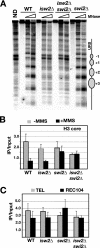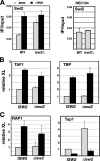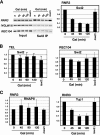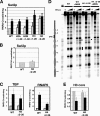A novel mechanism of antagonism between ATP-dependent chromatin remodeling complexes regulates RNR3 expression
- PMID: 19349301
- PMCID: PMC2698743
- DOI: 10.1128/MCB.01741-08
A novel mechanism of antagonism between ATP-dependent chromatin remodeling complexes regulates RNR3 expression
Abstract
Gene expression depends upon the antagonistic actions of chromatin remodeling complexes. While this has been studied extensively for the enzymes that covalently modify the tails of histones, the mechanism of how ATP-dependent remodeling complexes antagonize each other to maintain the proper level of gene activity is not known. The gene encoding a large subunit of ribonucleotide reductase, RNR3, is regulated by ISW2 and SWI/SNF, complexes that repress and activate transcription, respectively. Here, we studied the functional interactions of these two complexes at RNR3. Deletion of ISW2 causes constitutive recruitment of SWI/SNF, and conditional reexpression of ISW2 causes the repositioning of nucleosomes and reduced SWI/SNF occupancy at RNR3. Thus, ISW2 is required for restriction of access of SWI/SNF to the RNR3 promoter under the uninduced condition. Interestingly, the binding of sequence-specific DNA binding factors and the general transcription machinery are unaffected by the status of ISW2, suggesting that disruption of nucleosome positioning does not cause a nonspecific increase in cross-linking of all factors to RNR3. We provide evidence that ISW2 does not act on SWI/SNF directly but excludes its occupancy by positioning nucleosomes over the promoter. Genetic disruption of nucleosome positioning by other means led to a similar phenotype, linking repressed chromatin structure to SWI/SNF exclusion. Thus, incorporation of promoters into a repressive chromatin structure is essential for prevention of the opportunistic actions of nucleosome-disrupting activities in vivo, providing a novel mechanism for maintaining tight control of gene expression.
Figures







Similar articles
-
Exposing the core promoter is sufficient to activate transcription and alter coactivator requirement at RNR3.Proc Natl Acad Sci U S A. 2007 May 22;104(21):8833-8. doi: 10.1073/pnas.0701666104. Epub 2007 May 14. Proc Natl Acad Sci U S A. 2007. PMID: 17502614 Free PMC article.
-
Chromatin remodeling by ISW2 and SWI/SNF requires DNA translocation inside the nucleosome.Nat Struct Mol Biol. 2006 Apr;13(4):339-46. doi: 10.1038/nsmb1071. Epub 2006 Mar 5. Nat Struct Mol Biol. 2006. PMID: 16518397
-
Basis of specificity for a conserved and promiscuous chromatin remodeling protein.Elife. 2021 Feb 12;10:e64061. doi: 10.7554/eLife.64061. Elife. 2021. PMID: 33576335 Free PMC article.
-
Yeast chromatin remodeling complexes and their roles in transcription.Curr Genet. 2020 Aug;66(4):657-670. doi: 10.1007/s00294-020-01072-0. Epub 2020 Apr 1. Curr Genet. 2020. PMID: 32239283 Review.
-
ATP-dependent chromatin remodeling enzymes: two heads are not better, just different.Curr Opin Genet Dev. 2008 Apr;18(2):137-44. doi: 10.1016/j.gde.2008.01.007. Epub 2008 Mar 12. Curr Opin Genet Dev. 2008. PMID: 18339542 Free PMC article. Review.
Cited by
-
A highly conserved region within H2B is important for FACT to act on nucleosomes.Mol Cell Biol. 2014 Feb;34(3):303-14. doi: 10.1128/MCB.00478-13. Epub 2013 Nov 18. Mol Cell Biol. 2014. PMID: 24248595 Free PMC article.
-
Chromatin and transcription in yeast.Genetics. 2012 Feb;190(2):351-87. doi: 10.1534/genetics.111.132266. Genetics. 2012. PMID: 22345607 Free PMC article. Review.
-
Set2-dependent K36 methylation is regulated by novel intratail interactions within H3.Mol Cell Biol. 2009 Dec;29(24):6413-26. doi: 10.1128/MCB.00876-09. Epub 2009 Oct 12. Mol Cell Biol. 2009. PMID: 19822661 Free PMC article.
-
Genomic profiling of HMGN1 reveals an association with chromatin at regulatory regions.Mol Cell Biol. 2011 Feb;31(4):700-9. doi: 10.1128/MCB.00740-10. Epub 2010 Dec 20. Mol Cell Biol. 2011. PMID: 21173166 Free PMC article.
-
The chromatin remodelers RSC and ISW1 display functional and chromatin-based promoter antagonism.Elife. 2015 Mar 30;4:e06073. doi: 10.7554/eLife.06073. Elife. 2015. PMID: 25821983 Free PMC article.
References
-
- Agalioti, T., G. Chen, and D. Thanos. 2002. Deciphering the transcriptional histone acetylation code for a human gene. Cell 111381-392. - PubMed
-
- Berger, S. L. 2007. The complex language of chromatin regulation during transcription. Nature 447407-412. - PubMed
-
- Boyer, L. A., M. R. Langer, K. A. Crowley, S. Tan, J. M. Denu, and C. L. Peterson. 2002. Essential role for the SANT domain in the functioning of multiple chromatin remodeling enzymes. Mol. Cell 10935-942. - PubMed
-
- Cairns, B. R., A. Schlichter, H. Erdjument-Bromage, P. Tempst, R. D. Kornberg, and F. Winston. 1999. Two functionally distinct forms of the RSC nucleosome-remodeling complex, containing essential AT hook, BAH, and bromodomains. Mol. Cell 4715-723. - PubMed
Publication types
MeSH terms
Substances
Grants and funding
LinkOut - more resources
Full Text Sources
Molecular Biology Databases
